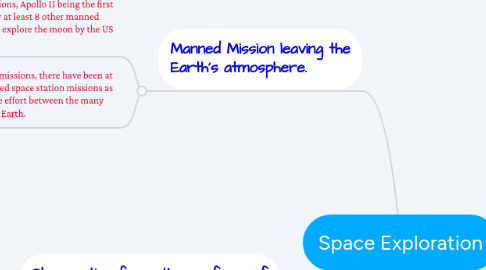Space Exploration
by David Vardaman


1. Manned Mission leaving the Earth's atmosphere.
1.1. Moon missions, Apollo 11 being the first followed by at least 8 other manned missions to explore the moon by the US since.
1.2. Space station missions, there have been at least 59 manned space station missions as a collaborative effort between the many nations of the Earth.
2. Unmanned Mission leaving the Earth's atmosphere.
2.1. NASA has made more than 1,000 unmanned missions to launch objects including but not limited to cameras, computers, vehicles, and food into the orbit of the Earth or beyond.
3. Observation from the surface of the Earth.
3.1. Mauna Kea Observatories Hawaii, a collection of telescope observatories used for deep space observation via light capturing devices.
3.1.1. Low light pollution allows for excellent levels of darkness ensuring better images.
3.1.2. The elevation of the observatories at 13,796 ft above sea level keep the telescopes above most water vapor in atmosphere to ensure clear images.
3.2. South Pole Telescope located in the Antarctic Treaty area near the south pole, used for deep space readings via microwave readings.
3.2.1. High altitudes over 1.7mi above sea-level, means the telescope has a relatively thin atmosphere to penetrate for readings.
3.2.2. The extremely low level of water vapor in the air due to exceptionally low temperatures means low interference as the microwaves move through the air.
